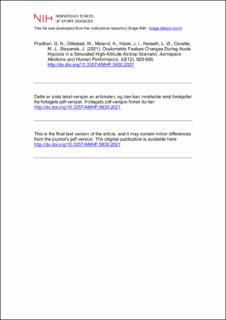| dc.contributor.author | Pradhan, Gaurav N. | |
| dc.contributor.author | Ottestad, William Arne | |
| dc.contributor.author | Meland, Anders | |
| dc.contributor.author | Kåsin, Jan Ivar | |
| dc.contributor.author | Høiseth, Lars Øivind | |
| dc.contributor.author | Cevette, Michael J. | |
| dc.contributor.author | Stepanek, Jan | |
| dc.date.accessioned | 2022-03-24T11:41:12Z | |
| dc.date.available | 2022-03-24T11:41:12Z | |
| dc.date.created | 2022-02-06T13:17:09Z | |
| dc.date.issued | 2021 | |
| dc.identifier.citation | Aerospace Medicine and Human Performance. 2021, 92(12), 928-936. | en_US |
| dc.identifier.issn | 2375-6314 | |
| dc.identifier.uri | https://hdl.handle.net/11250/2987317 | |
| dc.description | I Brage finner du siste tekst-versjon av artikkelen, og den kan inneholde ubetydelige forskjeller fra forlagets pdf-versjon. Forlagets pdf-versjon finner du på www.ingentaconnect.com / In Brage you'll find the final text version of the article, and it may contain insignificant differences from the journal's pdf version. The definitive version is available at www.ingentaconnect.com. | en_US |
| dc.description.abstract | BACKGROUND: Severe acute hypoxia results in a rapid deterioration of cognitive functioning and thus poses a risk for human operations in high altitude environments. This study aimed at investigating the effects of oxygen system failure during a high-altitude high-opening (HAHO) parachute jump scenario from 30,000 ft (9144 m) on human physiology and cognitive performance using a noncontact eye-tracking task. METHODS: Nine healthy male volunteers (ages 27–48) were recruited from the Norwegian Special Operations Commandos. Eye-tracking data were collected to derive information on cognitive performance in the context of rapid dynamic changes in pressure altitude while performing a modified King-Devick test. The baseline data was collected at 8000 ft (2438 m) while breathing 100% oxygen during decompression. For every test, the corresponding arterial blood gas analysis was performed. RESULTS: The study subjects endured severe hypoxia, which resulted in significant prolongations of fixation time (range: 284.1–245.6 ms) until 23,397 ft (131 m) and fixation size (range: 34.6–32.4 mm) until 25,389 ft (7739 m) as compared to the baseline (217.6 ± 17.8 ms and 27.2 ± 4.5 mm, respectively). The increase in the saccadic movement and decrease in the saccadic velocity was observed until 28,998 ft and 27,360 ft (8839 and 8339 m), respectively. DISCUSSION: This is the first study to investigate cognitive performance from measured oculometric variables during severe hypobaric hypoxia in a simulated high-altitude airdrop mission scenario. The measurement of altered oculometric variables under hypoxic conditions represents a potential avenue to study altered cognitive performance using noncontact sensors that can derive information and serve to provide the individual with a warning from impending incapacitation. | en_US |
| dc.language.iso | eng | en_US |
| dc.subject | acute hypoxia | en_US |
| dc.subject | cognitive performance | en_US |
| dc.subject | high-altitude high opening | en_US |
| dc.subject | oculometric | en_US |
| dc.title | Oculometric Feature Changes During Acute Hypoxia in a Simulated High-Altitude Airdrop Scenario | en_US |
| dc.type | Peer reviewed | en_US |
| dc.type | Journal article | en_US |
| dc.description.version | acceptedVersion | en_US |
| dc.source.pagenumber | 928-936 | en_US |
| dc.source.volume | 92 | en_US |
| dc.source.journal | Aerospace Medicine and Human Performance | en_US |
| dc.source.issue | 12 | en_US |
| dc.identifier.doi | 10.3357/AMHP.5930.2021 | |
| dc.identifier.cristin | 1998213 | |
| dc.description.localcode | Institutt for idrett og samfunnsvitenskap / Department of Sport and Social Sciences | en_US |
| cristin.ispublished | true | |
| cristin.fulltext | postprint | |
| cristin.qualitycode | 1 | |
